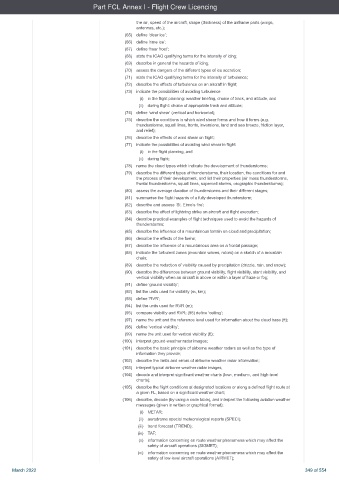Page 349 - UK AirCrew Regulations (Consolidated) March 2022
P. 349
Part FCL Annex I - Flight Crew Licencing
the air, speed of the aircraft, shape (thickness) of the airframe parts (wings,
antennas, etc.);
(65) define ‘clear ice’;
(66) define ‘rime ice’;
(67) define ‘hoar frost’;
(68) state the ICAO qualifying terms for the intensity of icing;
(69) describe in general the hazards of icing;
(70) assess the dangers of the different types of ice accretion;
(71) state the ICAO qualifying terms for the intensity of turbulence;
(72) describe the effects of turbulence on an aircraft in flight;
(73) indicate the possibilities of avoiding turbulence
(i) in the flight planning: weather briefing, choice of track, and altitude, and
(ii) during flight: choice of appropriate track and altitude;
(74) define ‘wind shear’ (vertical and horizontal);
(75) describe the conditions in which wind shear forms and how it forms (e.g.
thunderstorms, squall lines, fronts, inversions, land and sea breeze, friction layer,
and relief);
(76) describe the effects of wind shear on flight;
(77) indicate the possibilities of avoiding wind shear in flight:
(i) in the flight planning, and
(ii) during flight;
(78) name the cloud types which indicate the development of thunderstorms;
(79) describe the different types of thunderstorms, their location, the conditions for and
the process of their development, and list their properties (air mass thunderstorms,
frontal thunderstorms, squall lines, supercell storms, orographic thunderstorms);
(80) assess the average duration of thunderstorms and their different stages;
(81) summarise the flight hazards of a fully developed thunderstorm;
(82) describe and assess ‘St. Elmo’s fire’;
(83) describe the effect of lightning strike on aircraft and flight execution;
(84) describe practical examples of flight techniques used to avoid the hazards of
thunderstorms;
(85) describe the influence of a mountainous terrain on cloud and precipitation;
(86) describe the effects of the foehn;
(87) describe the influence of a mountainous area on a frontal passage;
(88) indicate the turbulent zones (mountain waves, rotors) on a sketch of a mountain
chain;
(89) describe the reduction of visibility caused by precipitation (drizzle, rain, and snow);
(90) describe the differences between ground visibility, flight visibility, slant visibility, and
vertical visibility when an aircraft is above or within a layer of haze or fog;
(91) define ‘ground visibility’;
(92) list the units used for visibility (m, km);
(93) define ‘RVR’;
(94) list the units used for RVR (m);
(95) compare visibility and RVR; (96) define ‘ceiling’;
(97) name the unit and the reference level used for information about the cloud base (ft);
(98) define ‘vertical visibility’;
(99) name the unit used for vertical visibility (ft);
(100) interpret ground-weather radar images;
(101) describe the basic principle of airborne weather radars as well as the type of
information they provide;
(102) describe the limits and errors of airborne weather radar information;
(103) interpret typical airborne weather radar images;
(104) decode and interpret significant weather charts (low-, medium-, and high-level
charts);
(105) describe the flight conditions at designated locations or along a defined flight route at
a given FL, based on a significant weather chart;
(106) describe, decode (by using a code table), and interpret the following aviation weather
messages (given in written or graphical format):
(i) METAR;
(ii) aerodrome special meteorological reports (SPECI);
(iii) trend forecast (TREND);
(iv) TAF;
(v) information concerning en route weather phenomena which may affect the
safety of aircraft operations (SIGMET);
(vi) information concerning en route weather phenomena which may affect the
safety of low-level aircraft operations (AIRMET);
March 2022 349 of 554

